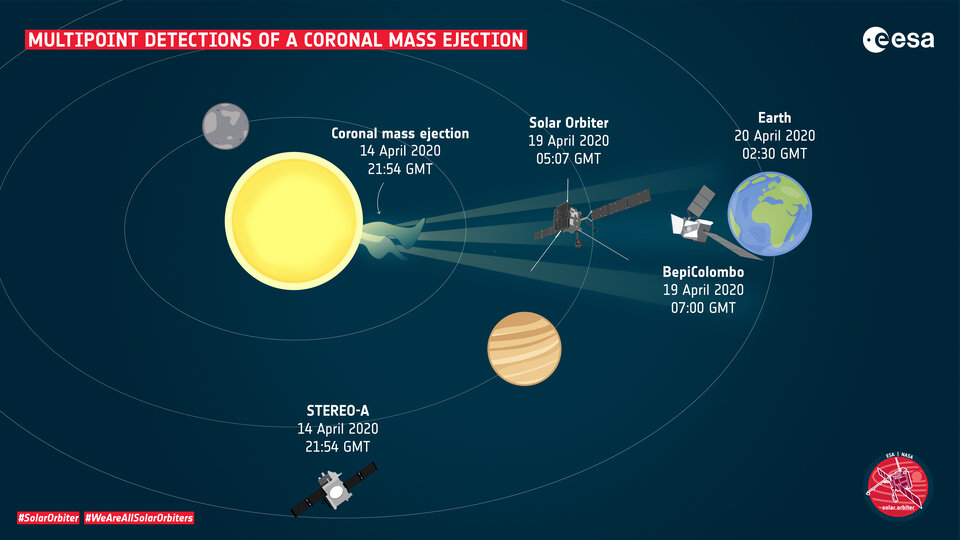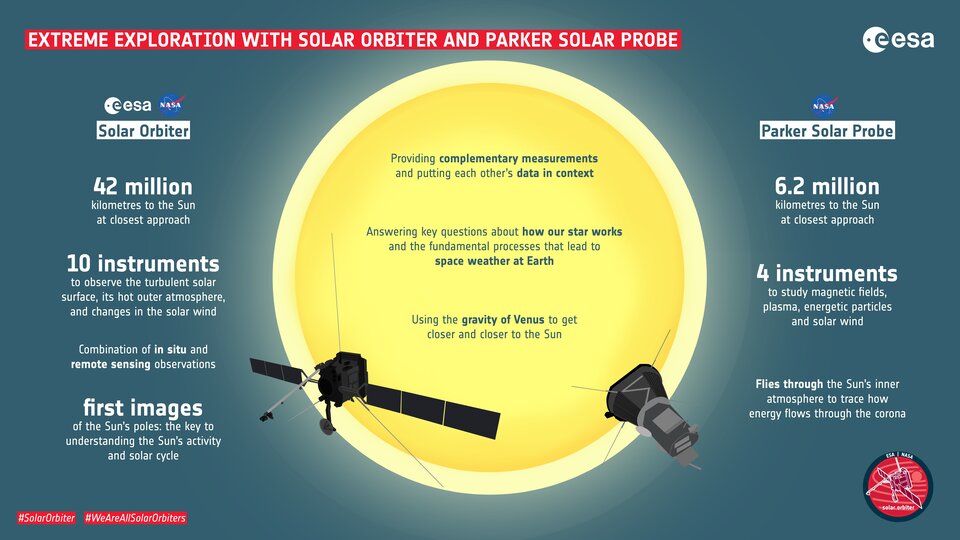The dawn of multipoint solar science
With its suite of ten state-of-the-art scientific instruments, Solar Orbiter will enable scientists to gain an entirely new level of understanding about the behaviour of the Sun. But there is more on offer than even this. Solar Orbiter is not the only spacecraft exploring the Sun and the inner Solar System. Together with NASA’s Parker Solar Probe and ESA’s Mercury-bound BepiColombo, there is a network of spacecraft that can work together to build an unprecedented three-dimensional understanding of the Sun and its effects.
Solar Orbiter took to the skies in February 2020. Immediately after launch, controllers on the ground began commissioning the spacecraft. This involved checking out its various systems and instruments to get the mission ready for collecting science. It was just as well they started as early as they did because in April, a fascinating opportunity presented itself.
Solar Orbiter was approaching Venus, which was more-or-less directly in between the Earth and the Sun at the time. Back towards the Earth, at an orbital sweet-spot known as L1, was the venerable ESA-NASA Solar and Heliospheric Observatory (SOHO) mission, and NASA’s Advanced Composition Explorer (ACE). Finally, near Earth itself, ESA’s BepiColombo mission was performing a flyby to help it on its grand voyage to Mercury. So there was a line of spacecraft from Solar Orbiter, through SOHO and ACE, back to BepiColombo near Earth.

Tim Horbury, Imperial College, London, and the Principal Investigator of Solar Orbiter’s Magnetometer (MAG) instrument takes up the story. “While we were there, an enormous coronal mass ejection barrelled right over the top of us. It went over the top of us, it went over Bepi, it went over on the Earth. And this was the first time we've been able to measure a coronal mass ejection at multiple distances from the Sun with spacecraft that are relatively close to each other,” he says.
The coronal mass ejections are the most energetic space weather events known. They explode outwards from the Sun, propelling billions of tonnes of particles through the Solar System. They can create intense aurorae on planets with atmospheres and can interfere with electronic technology in space and on the ground.
Understanding the behaviour of these events is one of Solar Orbiter’s scientific objectives, and in analysing the data from April, Tim and colleagues saw that they could discern the changes in the CME as it travelled between the spacecraft. They picked up the shock wave from the leading edge of the eruption and saw how it evolved from one point in space to the next. “We could really look at the anatomy of this coronal mass ejection,” says Tim.
It was a powerful demonstration of ‘multipoint science’, a discipline that combines data from multiple spacecraft to build bigger pictures and understanding. “Multipoint science is going to be very, very powerful,” says Tim, “Before, it’s been like having a painting that’s been covered in black, and scratching off a single point and trying to work out what the painting looks like. That’s incredibly difficult but now we effectively have a constellation of spacecraft in the inner solar system, and we're going to end up with lots of configurations with multiple points revealed.”
And when it comes to understanding the Sun’s behaviour, this approach is vital because the Sun's effects are so vast.
The engine of the Solar System
The Sun is the great engine of the Solar System. As well as releasing energy every second in the form of light and other wavelengths, it also produces a constant flux of particles. Known as the solar wind, this is made of electrically charged particles – ions and electrons – that combine into a gas known as a plasma. Being electrically charged means that the plasma of the solar wind can both carry and respond to magnetic fields. Hence, travelling away from the Sun at velocities of hundreds of kilometres per second, the solar wind creates the heliosphere, a vast bubble of magnetism that surrounds the Solar System.
Solar Orbiter’s unique ability to link events on the Sun’s surface to what subsequently happens to the particles and magnetic field around the spacecraft is unparalleled in the history of solar observation but as was shown in April 2020, the science return can be enhanced by combining its data with that from other spacecraft.
Recognising the connections
In 2019, at a BepiColombo science meeting at ESA’s technical centre ESTEC, in Noordwijk, The Netherlands, a number of scientists who are also connected to Solar Orbiter proposed that during some phases of the mission it could collect information that would be useful for putting Solar Orbiter’s data into a wider context. Intrigued by the idea of such work, both missions set up a joint working group to investigate the possibilities. Many of the members of this working group were young scientists just at the beginning of their science careers. They brought a distinct energy to the work, and did an excellent job.
“They found a lot of opportunities for the two missions to work together,” says Johannes Benkhoff, ESA Project Scientist for BepiColombo.
Because it is travelling into the Solar System to visit the inner planet Mercury, BepiColombo is equipped with particle detectors that can sample the solar wind. One of these is the Search for Exospheric Refilling and Emitted Natural Abundance (SERENA) instrument on BepiColombo’s Mercury Planetary Orbiter. Onboard the Mercury Magnetospheric Orbiter (also called Mio), there is the Mercury Plasma Particle Experiment (MPPE). Both orbiters also carry radiation sensors and magnetometers.
“The beauty is that we can combine with Solar Orbiter to give multi-point measurements at different distances from the Sun,” says Johannes.

Another spacecraft where there is a clear mutual benefit from collaboration is NASA’s Parker Solar Probe. Launched from Cape Canaveral on a Delta IV Heavy rocket on 12 August 2018, Parker Solar Probe was named after Eugene Parker, the American solar physicist who developed the theory of the solar wind in 1958, and in 1987 proposed that the Sun’s outer atmosphere is heated by ubiquitous miniature solar flares.
Parker Solar Probe carries a smaller payload than Solar Orbiter. It consists mainly of particle detectors and magnetometers rather than telescopes and cameras to look at the solar surface but it goes much closer to the Sun. On 7 June 2020, it passed the solar surface at a distance of around 19.4 million kilometres, and this will only get closer during the 24 close encounters it is expected to have with the Sun. In 2025, it will pass within 6.9 million kilometres of the Sun’s surface on at least three separate occasions.
Parker Solar Probe is targeting the region were the plasma in the corona is thought to be accelerated away from the Sun to become the solar wind, but without telescopes it cannot tie what it is sensing to events on the solar surface. But it does not have to because this is information that Solar Orbiter’s telescopes and cameras can provide.
“We can look at the region from where the matter gets ejected and is later measured by Parker Solar Probe,” says Yannis Zouganelis, ESA Solar Orbiter Deputy Project Scientist.
This process is a two-way street. The NASA spacecraft carries the Wide-Field Imager for Parker Solar Probe (WISPR) instrument. It does not look at the Sun, but looks in the direction that the spacecraft is travelling, so that it can take images of light that is scattered by electrons in the corona. Depending on where the two spacecraft are, this is expected to sometimes reveal matter that will subsequently flow across Solar Orbiter.
“Both missions are very complimentary, and so we are collaborating to make sure that we don’t miss unique opportunities,” says Yannis.
The chance to conduct joint investigations of this nature was recognised even before the missions were launched.
“The number of times that we have really outstanding conjunctions between the two spacecraft is staggering,” says Nicola Fox, the director of the NASA’s Science Mission Directorate Heliophysics Division, Washington DC. “There are so many times where they're either directly in line or they're offset enough that they would be on the same magnetic field line or they're 90 degrees apart. There is just amazing science you can do with all of these different configurations.”
Indeed, interesting conjunctions between Solar Orbiter and Parker Solar Probe have already begun. Solar Orbiter’s first close pass to the Sun on 15 June 2020 took place close to Parker’s fifth close pass, which happened about a week earlier on 7 June.
"We're already doing the comparisons, we're already looking at what the solar wind is like from the same place on the Sun at multiple distances to see how it evolves with distance and in time,” says Tim.
And the discoveries are set to continue for years. Solar Orbiter’s mission is designed to last until at least 2030. By then, the spacecraft will be in a highly inclined orbit, looking at the poles of the Sun. This will give scientists another different vantage point to help fill in their picture of the heliosphere.
When it comes to BepiColombo, the next obvious opportunity for multipoint science comes in August 2021. BepiColombo is due to fly past Venus just a few days after Solar Orbiter. “We hope that we get a lot of common measurements with some of our instruments and cross calibrate them with Solar Orbiter,” says Johannes.
And it is not just spacecraft that can be coordinated in these observing campaigns. There are dozens of ground-based observatories that can be trained on the Sun as well. “It is a great time to be a solar scientist. All of these assets working together is just really fantastic,” says Nicola.


